Dystopian Novels - PowerPoint PPT Presentation
1 / 18
Title:
Dystopian Novels
Description:
Dystopian Novels Definition Check: Utopian Utopian refers to human efforts to create a hypothetically perfect society. It refers to good but impossible proposals - or ... – PowerPoint PPT presentation
Number of Views:1042
Avg rating:3.0/5.0
Title: Dystopian Novels
1
Dystopian Novels
2
Definition Check Utopian
- Utopian refers to human efforts to create a
hypothetically perfect society. - It refers to good but impossible proposals - or
at least ones that are difficult to carry out.
3
Dystopian versus Utopian
- Dystopian is the opposite of utopian it is often
a utopia gone sour, an imaginary place or state
where everything is as bad as it could possibly
be.
4
Dystopian Novels
- Dystopian novels usually include elements of
contemporary society and are seen as a warning
against some modern trend. - Writers use them as cautionary tales, in which
humankind is put into a society that may look
inviting on the surface but in reality, is a
nightmare.
5
Characteristics of Dystopian Literature
- Fictional and futuristic
- Dystopias serve as warnings to contemporary man
- Comment on our own current society
- Strong focus on Technology
6
Ray Bradbury
- You dont have to burn books to destroy a
culture. Just get people to stop reading them.
7
Ray Bradbury
- Born in 1920
- Americas best known writer of science fiction
- Sold his first story in 1940- has written over a
thousand stories since then - Creates wildly imaginative visions of the future
as entertainment but with a serious purpose - Concerned for the future
8
The Times
- Anti-communist movement led by Senator Joseph
McCarthyblack listed Hollywood actors, book
burning, banned booksin the 1940s-1950s
(McCarthy Era). - Cold War Era
- Korean War
- Rise of TV
- Increase of technology
9
The 1950s and the TV
- 1953- TVs began showing up in homes
- Americans quickly fell in live and everyone
managed to purchase a TV for their house. - Radios and Movie Theatres lost all business
- Ray Bradbury witnessed this, and his vision of
how TV could eventually affect American life
became a fundamental theme of Fahrenheit 451.
10
1950s and Conformity
- Suburbs began to develop
- Hairstyles, clothing, thinking, and behavior were
all standardized. - Individuality was frowned upon or laughed at.
11
The 1950s Housewife
- Women were mothers and homemakers.
- A womans place is in the home
- Women became addicted to daytime soaps
- Nicknamed soaps by the manufacturers of
household products who sponsored the shows with
the hope that their products would become as
addictive as the story lines.
12
Fahrenheit 451
- Fahrenheit 451 by Ray Bradbury (1953)
- The story takes place in the twenty-first
century, in an America where books are banned. - Society feels that opinion books contain
conflicting theories which are disruptive to
society. - The penalty for owning one is having one's house
and books burnt by "firemen." - 451 F is stated as the temperature at which
book paper catches fire and burns
13
Themes
- Censorship
- Knowledge Vs. Ignorance
- Literature and Writing
- Technology and Modernization
- Rules and Order
14
Narration
- Third-person, limited omniscient follows
Montags point of view, often articulating his
interior monologues
15
Characters
- Guy Montag
- Mildred Montag
- Captain Beatty
- Stoneman Black
- Clarisse McClellan
- Professor Faber
- Mrs. Phelps Mrs. Bowles
- Granger
16
Literary Devices
- Symbolism A symbol in literature is the use of
one thing to represent an entire set of ideas. In
this novel the central symbol is that of fire
representing the extinguishing of thinking,
imagining, and appreciating. - Alliteration Alliteration is the repetition of
one letter sound in order to produce a desired
effect. - Metaphor A metaphor is an implied comparison
between two seemingly unlike objects. - Simile A simile is a comparison of two
seemingly unlike objects which uses the words
"like" or "as." - Irony A situation is ironic when it becomes the
exact opposite of what is intended. - Foreshadowing These are the authors hints as
what is to take place in future time within the
novel
17
Relation to the Real World
- In the novel, Bradbury combined several issues of
his contemporary society - The burnings of books in Nazi Germany.
- The explosion of a nuclear weapon.
- The author also addresses the concern that the
presence of fast cars, loud music, and
advertisements creates a lifestyle with too much
stimulation where no one has the time to
concentrate. - He also addresses concerns about censorship at
the expense of personal expression.
18
Summary
- The dystopian literature of the period reflected
the many concerns that resonated throughout the
twentieth century. - The concept of a dystopia was introduced to help
reveal the potential consequences of a utopia
turning against itself.

















![[DOWNLOAD]⚡️PDF✔️ Parable of the Sower: A Graphic Novel Adaptation PowerPoint PPT Presentation](https://s3.amazonaws.com/images.powershow.com/10136124.th0.jpg?_=20240923126)
![[PDF]❤️DOWNLOAD⚡️ Parable of the Sower: A Graphic Novel Adaptation PowerPoint PPT Presentation](https://s3.amazonaws.com/images.powershow.com/10132160.th0.jpg?_=20240917100)
![[PDF]❤️DOWNLOAD⚡️ Parable of the Sower: A Graphic Novel Adaptation PowerPoint PPT Presentation](https://s3.amazonaws.com/images.powershow.com/10134151.th0.jpg?_=20240920037)


![[DOWNLOAD]⚡️PDF✔️ Parable of the Sower: A Graphic Novel Adaptation PowerPoint PPT Presentation](https://s3.amazonaws.com/images.powershow.com/10134152.th0.jpg?_=20240920037)
![[PDF]❤️DOWNLOAD⚡️ Parable of the Sower: A Graphic Novel Adaptation PowerPoint PPT Presentation](https://s3.amazonaws.com/images.powershow.com/10136123.th0.jpg?_=20240923126)







